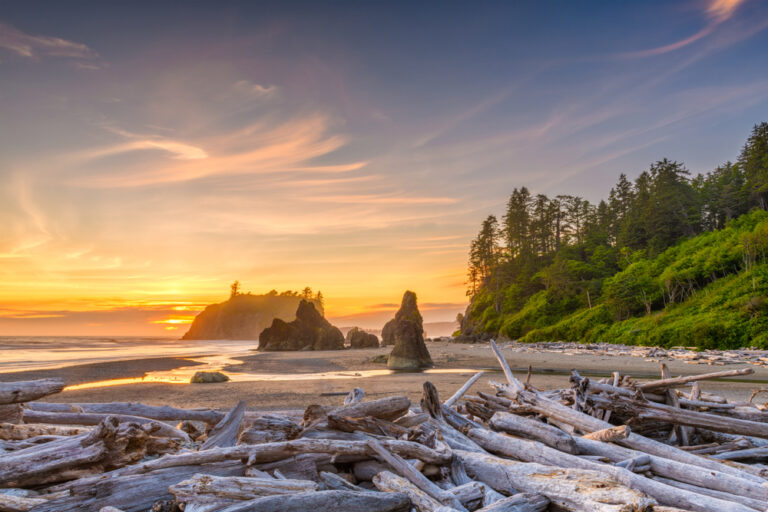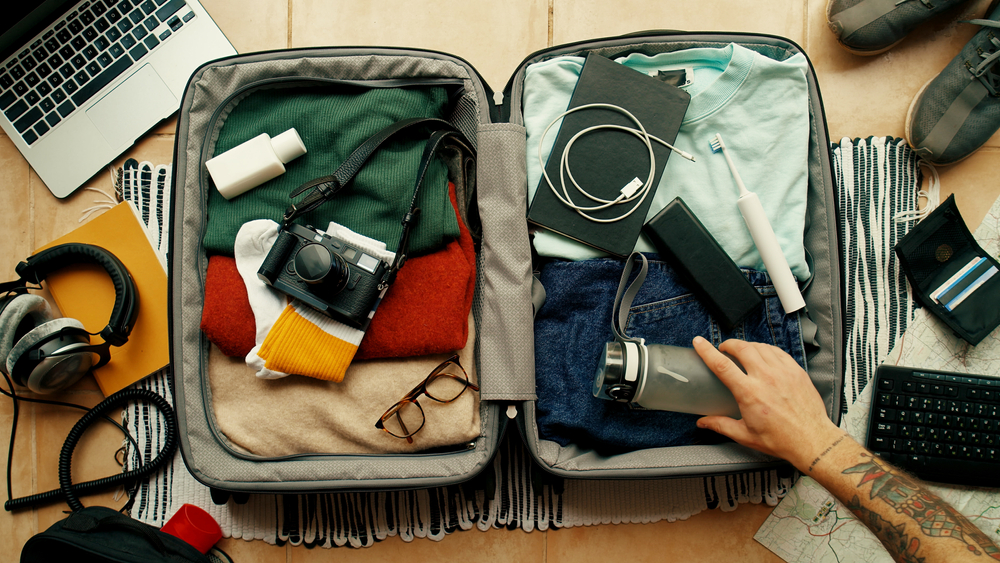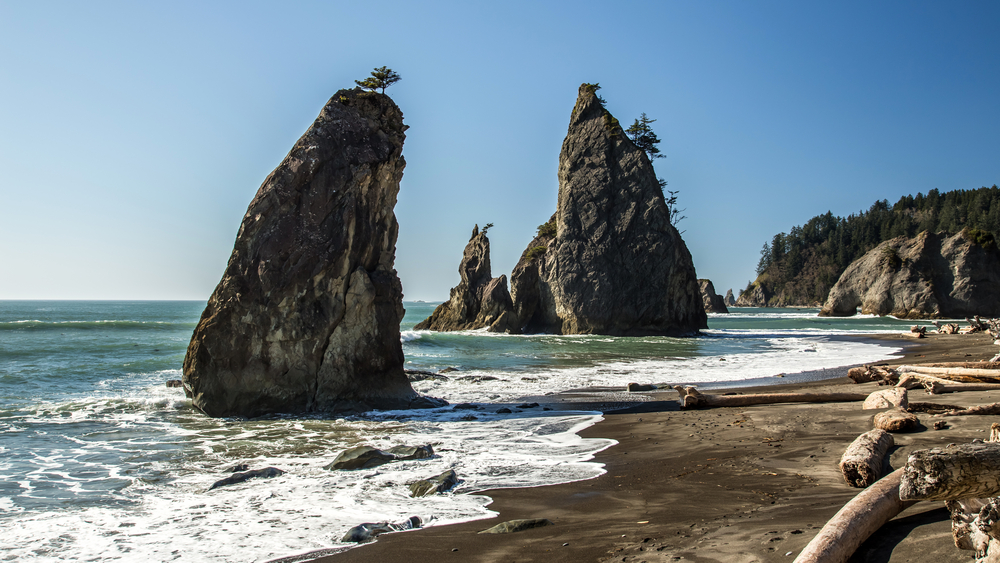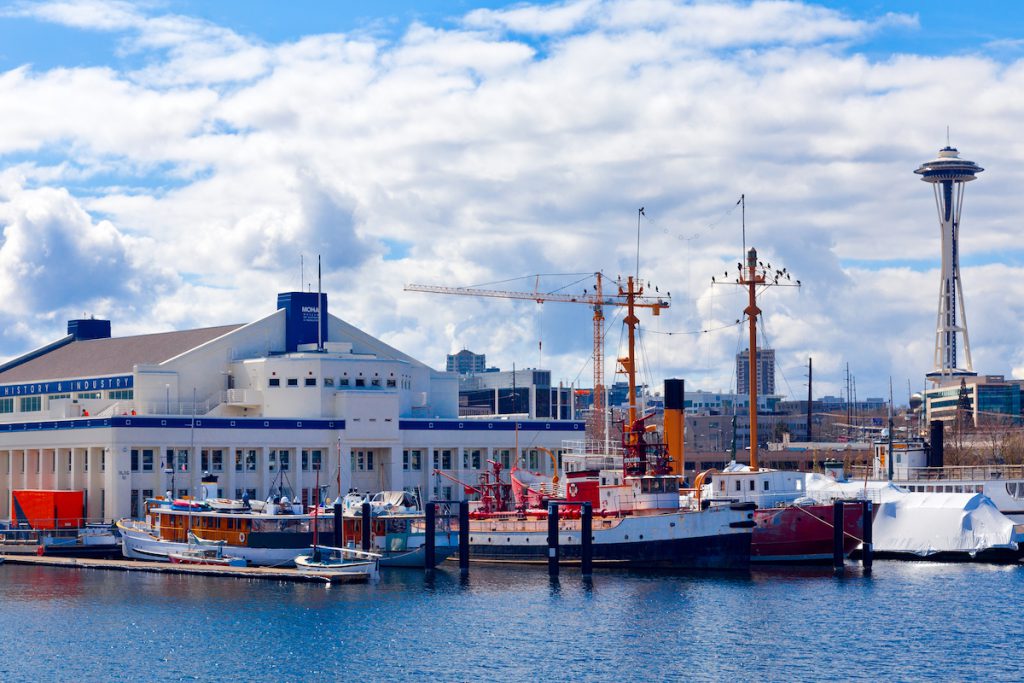
An RV camping trip in Washington is an unforgettable experience! The Pacific Northwest has breathtaking mountains, exciting and interesting cities, and lots of untouched forest for exploring. Whether you’re heading on a summer road trip, a fall foliage tour, or another road trip around the state, you’re sure to make memories.
If you’re looking for a guide to help you plan an awesome trip to the Evergreen State, you’re in the right place! This article will share everything you need to know to plan an epic Washington getaway.
Preparing for RV Camping
The first step on an RV camping trip to Washington is…having an RV. If you don’t have your own trailer, camper, or motorhome, you can rent one from RVshare. Once you’ve rented an RV, you’ll want to make sure it’s packed with everything you need for your trip.
Choosing the right RV for your needs
If you’ll be renting an RV, you’ll want to think about a few things before you rent! Consider the size of your family, or the group you’re camping with. If you’ll be going solo, or with one other person, you can rent a much smaller vehicle than if you’re traveling with a big family. Also, what amenities do you want in an RV? Campers and trailers run the gamut from simple trailers with no bathrooms and kitchens to large Class A motorhomes with washing machines and fireplaces…and everything in between. Check out our description of each kind of motorhome and trailer so you can determine what you need.
You’ll also want to consider whether you want a vehicle at your destination. If you’re renting a Class A motorhome, you may have to tow a vehicle behind you. A trailer allows you to unhitch your vehicle after setting up camp so you can explore. A smaller campervan can simply serve as your vehicle during the day and be parked at the campsite at night.
Packing essentials for a successful trip
After you’ve nailed down an RV, you’ll want to make sure you have everything you need to bring along for your trip! It might be useful to make two lists – one for your personal items that you need to bring, and one for the things you need for your RV.
Personal Packing List:
- Clothing – be sure to pack enough for your trip, or enough for between laundry days
- Toiletries
- Medications
- Bug spray or citronella candles
- Sunscreen
- First Aid kit
- Outdoor recreation clothing (hiking boots, bathing suit, or other specialized clothing)
- Winter or summer accessories (winter hats, gloves, sun hat, etc)
- Flashlight
- Entertainment (books, games, movies)
- Extra batteries
- Groceries
- Electronics & chargers
- Pet supplies
- Quarters for showers or laundry
You’ll also want an RV packing list to make camping more comfortable. If you’re renting an RV, be sure to check what comes with your rental. Some include items like dishes, linens, and even outdoor equipment, while others do not.

RV Packing List:
- Pots & pans
- Dishes
- Utensils – don’t forget a can opener, bottle opener, spatula, set of knives, etc.
- Dish towels & sponges
- Sheets & pillows
- Bath Towels
- Tool kit
- Folding camp chairs
- Blankets
- RV leveling blocks
- Sewer hose and adapter
- Freshwater hose
- Surge protector
Considerations for Camping in Washington
Washington is notorious for its rainy weather, and you’ll want to make sure you have plenty of waterproof gear, especially if you’re visiting from October to March. You’ll also want to be careful of wet roads and drive carefully to avoid sliding or hydroplaning.
You’ll also want to know the RV driving laws in Washington state! Each state has different laws and regulations, and it’s up to the driver to know and abide by those laws. The maximum width your RV can be in Washington is 102 inches, the maximum length is 46 feet, and the maximum height is 14 feet. The maximum combined length for two vehicles (where one is being towed) is 60 feet. Towing two vehicles (triple-towing) is not allowed. Passengers are allowed to ride in truck campers, and trailers are not allowed in carpool lanes. All RVs must have flares or reflective signs, fire extinguishers, and safety chains. General driving laws in Washington state allow right turns on red lights unless posted otherwise.
Researching campground options and making reservations
You have lots of choices of where to camp in Washington! Begin your planning by thinking about where you want to visit in the state. Washington has three national parks, several large cities, sports teams including the Seahawks and the Kraken, and lots of places for outdoor adventures.
Once you’ve decided where you’re going to visit in Washington, you can look for specific campgrounds in the area. There are several websites that can help you find campsites and book your reservations online. The Dyrt, Hipcamp, and Roverpass are all great places to being your search for a campsite. Harvest Hosts links RVers with thousands of farms, wineries, and other scenic places you can visit and camp.
If you’re camping during the summer in Washington, you’ll want to make reservations well ahead of time to be sure you get a spot.

Finding Campgrounds
There are numerous campgrounds in Washington State! In fact, your biggest challenge might be narrowing down your favorite picks. As you search, keep in mind the kinds of things you need in a campground. Do you want a budget trip with fewer amenities and a smaller price? Do you want a campground resort with a pool and activities for kids? Deciding where you’ll stay and how you want to travel will be very helpful in choosing a campground.
Exploring public campgrounds in the state
Public campgrounds are a great budget option for RV campers! They range from bare-bones campsites with pit toilets to well-groomed campsites with showers and laundry facilities. You’ll want to check the campground listing carefully to see what’s included at your campsite. You’ll want to know if there are hookups, or if you’ll need your own electricity and will need to visit a dump station. You can find public campgrounds at national parks, national forests, state parks, and on Bureau of Land Management land.
National Park Camping
Washington has three national parks, along with several other national historical parks, recreation areas, historic trails, and other federally-designated lands. Washington’s national parks are:
All of these parks allow RV camping, but you’ll definitely want to reserve sites ahead of time! You may find even more campgrounds nearby, but outside of national park boundaries.
National Forest Camping
As part of the Pacific Northwest, Washington has wide areas of national forest across the state. These forests include:
- Colville National Forest
- Gifford Pinchot National Forest
- Mount Baker–Snoqualmie National Forest
- Okanogan-Wenatchee National Forest
- Olympic National Forest
There are lots of beautiful places to camp in these forests. The Edgewater Campground in Colville National Forest is on the banks of the Pend Oreille River. Camping in the Olympic National Forest puts you near nature and waterfall trails. Mount Baker–Snoqualmie National Forest has picturesque lakes and forest trails.
State Park Camping
There are also many amazing state parks in Washington! Some of the best places to camp include Lake Chelan State Park in the Cascade Mountains. Lake Chelan itself is one of the bluest, most pristine lakes in all of Washington. Illahee State Park is a beachfront park on Port Orchard Bay where you can harvest shellfish, swim, dive, and waterski.

Exploring private campgrounds and RV parks
Private campgrounds and RV resorts can often be much fancier (and more expensive!) than public campgrounds. You’ll find plenty of glamping options with beautiful views and roomy campsites. You’ll also find private campgrounds geared towards families, with pools and planned activities. You can also find simpler private campgrounds with clean restrooms with showers, laundry facilities, hookups, and dump stations.
, as well as more basic private RV parks that still offer simple luxuries such as clean restrooms with showers, laundry facilities, electrical hookups, and dump stations.
You can’t go wrong booking one of the following private campgrounds in Washington:
Oostema Farmstead
This working farm has 117-acres, where the owners keep Wagyu cattle. You’ll be staying amongst lovely, green farmland, and each site has grassy sites and its own fire pit. The campground is also pet-friendly so you can bring your pooch.
Riverbend RV Park
This park in the Methow Valley puts you next to a picturesque river where you can relax and enjoy the view. Full hookups, WiFi, and clean restrooms and showers make this an easy, low-stress place to camp.
Boondocking in Washington
Whether you’re looking to save money on your RV camping trip, or you just want to get off-grid for a while, boondocking is a great option! The national forests are going to be your best bet for dispersed camping in Washington State. Some dispersed camping does require a permit, however, which may cost a small fee. Make sure you know where you are allowed to camp and whether a fee is required.

Planning your itinerary
Now that you have your RV and your campground lined up, it’s time to make solid plans on what you’re doing on your trip to Washington. You can visit urban areas like Bellingham, Seattle, or Spokane. You can visit the state’s natural areas. You can check out the Space Needle, or the Chihuly Garden and Glass with its gorgeous glass creations. No matter your interests, you’ll find something to do in Washington!
Features and attractions in Washington
One of the best ways to see Washington is by driving a scenic byway! The Cascade Loop Scenic Byway winds from Puget Sound, through Leavenworth, to the Methow and Skagit Valleys and North Cascades National Park. The Cape Flattery Tribal Scenic Byway on the Makah Indian Reservation is the northernmost point in America. You’ll also want to hit up Washington’s famous landmarks. Snoqualmie Falls has observation decks and hikes to great places to view the falls. San Juan Island National Historic Park is off the coast of western Washington and is a great spot for whale watching. You might also want to visit Ebey’s Landing National Historical Reserve or the Klondike Gold Rush National Historical Park.
Festivals, fairs, and events in Washington
There are plenty of events that occur in Washington each year, and you may want to plan a camping trip around one of them! The Washington State Fair takes place in Puyallup each September. The Watershed Music Festival in George features multiple stages with live country bands and singers.
Exploring Outdoor Activities in Washington
The Pacific Northwest just beckons everyone to get outdoors! You can hike, mountain bike, rock climb, horseback ride, whitewater raft, and much more.
Hiking, biking, and nature trails
There are, unsurprisingly, lots of nature trails in Washington! Hiking and biking are some of the best ways to get out in nature and see the striking majesty of Washington’s natural features.
Here are some of the best hiking trails in Washington for you to try:
- Rattlesnake Ledge Trail
- Wallace Falls via Woody Trail
- Mount Storm King
- Twin Falls Trail
- Sol Duc Falls Trail
If you enjoy mountain biking more than hiking, try one of these mountain biking trails!
- Coyote Wall Loop Trail
- Woodburn Falls and Round Lake
- Lighthouse Point via Bowman Bay
- Lower Falls Creek Trail
- Green Mountain Lookout via Gold Creek Trail
Fishing, boating, and water activities
It’s no secret that Washington has plenty of water! From boating on lakes to fishing in streams to enjoying the Pacific Ocean, you can find a sport or water activity that interests you in Washington. Lake Wenatchee State Park is a good place to go swimming or boating. You can go whitewater rafting on the White Salmon River, the Skykomish, and more than ten rivers in the state. There are also lots of fishing spots along the Washington lakes and rivers.
You can also head out to find some of Washington’s breathtaking waterfalls! Spray Falls and Myrtle Falls are lovely places to plan a visit!
Wildlife viewing and photography
Washington is home to a variety of wildlife, and it can be exciting watching for and photographing animals! Bears, otters, seals, moose, bobcats, elk, and other smaller animals all call Washington home. The Billy Frank Jr. Nisqually Wildlife Refuge is an optimal spot for wildlife viewing and birdwatching. The Skagit River Bald Eagle Interpretive Center has guided nature walks to eagle viewing sites. There are also lots of mountain goats living in the Cascade and Olympic Mountains!

Family-friendly activities and attractions
If you’re RVing in Washington as a family, there are lots of family activities to try! Whether you visit some of the big cities, small towns, or natural areas of Washington, you’re sure to make lots of memories together.
Historical sites and museums
If you want your RV camping trip to combine fun and education, there are lots of sites to learn about history, science, and art as it relates to the Pacific Northwest. Fort Vancouver National Historic Site shares the history of the fur trade, the stories of Native Americans, the story of European settlement, and much more.
Other historic sites in Washington include:
- Ebey’s Landing National Historical Reserve
- Ice Age Floods National Geologic Trail
- Klondike Gold Rush National Historical Park
- Lewis & Clark National Historical Park
- Manhattan Project National Historical Park
- Nez Perce National Historical Park
- Oregon National Historic Trail
- San Juan Island National Historical Park
- Whitman Mission National Historic Site
If you want to spend a day at the museum, Washington has so many choices you may find it hard to pick one! The Wing Luke Museum shares the art, culture, and history of Asian Americans, Native Hawaiians, and Pacific Islanders. The Museum of Pop Culture is a fun trek through modern-day trends and the Museum of History and Industry shares the innovation of the Puget Sound region.
Amusement parks, zoos, and wildlife refuges
You’ll also find lots of fun theme and water parks in Washington! Wild Waves Theme & Water Park is just outside of Seattle and has thrilling rollercoasters and water rides. Remlinger Farms is a collection of amusement park rides on a working farm in Carnation.
Head to the award-winning Woodland Park Zoo in Seattle to see nearly 240 animal species. The Point Defiance Zoo & Aquarium in Tacoma is the only combined zoo and aquarium in the Pacific Northwest. The Kids Zone features interactive exhibits for children.
Look for deer, elk, coyotes, beavers, and a variety of birds at the Conboy National Wildlife Refuge in the South Cascades. The Dungeness National Wildlife Refuge on the Olympic Peninsula has one of the world’s longest sand spits, which shelters lots of marine life. Look for lots of native birds, harbor seals and their pups, and salmon and steelhead nurseries.

Safety and Preparedness when RV Camping in Washington
Of course, there is risk with any activity and there are a few things to be aware of when RV camping in Washington. If you know the common dangers of camping in the area, you can be better prepared in case of an emergency.
Weather conditions and natural disaster preparedness
The natural disasters most likely to occur in Washington include flooding and severe storms with lightning or hail. Tsunamis along the coast are unlikely but possible. Washington also gets earthquakes which are occasionally strong enough to cause damage. Finally, wildfires are another concern in many parts of the state.
If you are in danger of a flood, be careful where you drive your RV. Sometimes drivers don’t realize how deep a flooded area is and get their vehicles stuck while trying to drive through flooded streets. Head to higher ground. Listen to local weather reports so you know whether rain will continue, and where flooding may be happening. Local reports can also update you on whether you need to evacuate the area.
If you experience an earthquake while in your RV, seek shelter under a table and away from heavy light fixtures and windows. If your rig is near trees, light poles, or other outdoor hazards that could fall and crush it, you may want to run outside instead. If you can, avoid these dangers when you park your RV beforehand. After an earthquake, don’t light candles or matches in case there is a propane leak. Have flashlights ready to use in an emergency.
If you’re near the ocean during an earthquake, there is the possibility of a tsunami, although they are rare. Leave the coast and head inland as quickly as possible. Listen to local reports for tsunami warnings. Waves from a tsunami can take hours before they hit land, so continue to listen for reports.
Finally, be sure to practice fire safety when you’re RV camping in Washington! Make sure you know about any fire restrictions at your campground. Learn to safely start and extinguish a campfire so a wildfire can’t be started by any remaining embers. Check weather reports for heat or drought conditions that could make fire danger worse. You may also want to consult a fire map to be sure the area you plan to camp is safe.
Wildlife encounters and precautions
Washington has lots of wildlife including bears, moose, elk, coyotes, bobcats, and smaller animals like otters and raccoons. If you’re near the coast, you might see seals or even whales and dolphins.
If you’re hiking or camping in bear, moose, and other large-animal country, be sure to give them plenty of room. Use the thumb rule – hold your thumb an arm’s length away from you. If you can’t cover the animal completely with your thumb, you’re too close. Make noise as you hike to avoid scaring the animals. Back at your camp, be sure to put away any food and other scented items in a bear box or animal-safe container so you don’t attract animals at night. Don’t allow small children or pets to run ahead of you on the trail.
Washington is a wonderful slice of the Pacific Northwest! Whether you spend time in cosmopolitan cities or the backcountry, you’re sure to make some great memories!
More Inspiration for Your Washington Travels
- Top 8 Amusement Parks in Washington
- Urban Camping in Washington
- Top 10 Waterfalls in Washington
- Luxury Camping in Washington
- Glamping in Washington
- Fishing in Washington
- Top 10 Beaches in Washington
- The Top 31 Bucket List Destinations in Washington
- Boondocking in Washington
- Top 10 Landmarks in Washington
- The 10 Best RV Trips to Take in Washington
This post may contain affiliate links.
